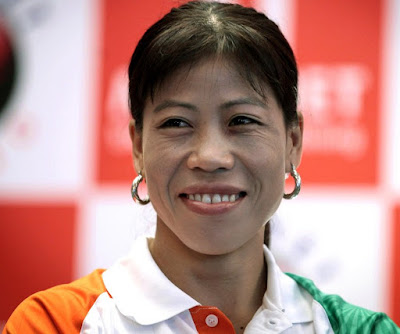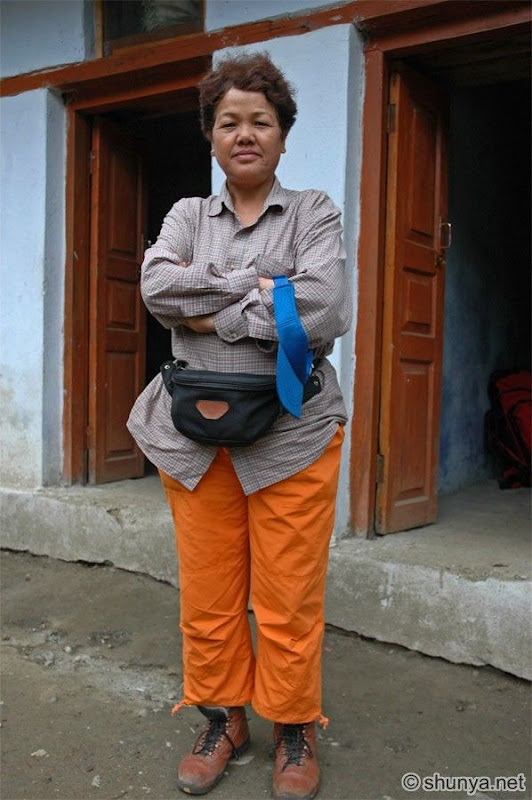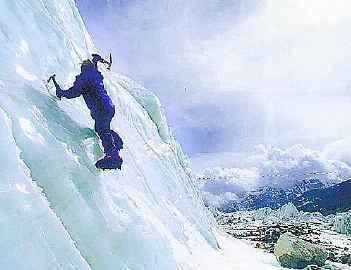Mary Kom Biography Education Achievements, Mary Kom Career High Lights Achievements
Mangte Chungneijang Mary Kom, ( born 1st March, 1983 ), also known as MC Mary Kom, Magnificent Mary or simply Mary Kom, is an Indian boxer belonging to Kom tribal community of north-eastern state of Manipur.
Nick Name : Magnificent Mary (Mary Kom)
Born :01 Mar,1983
Location :Bishnupur, Manipur, India
Website : http://mcmarykom.com/
She is a five-time World Boxing champion, and the only woman boxer to have won a medal in each one of the six world championships. She is the only Indian woman boxer to have qualified for the 2012 Summer Olympics, competing in the flyweight ( 51 kg ) category and winning the bronze medal. She has also been ranked as No. 4 AIBA World Women’s Ranking Flyweight category Mary Kom was born in Kangathei, in Churachanpur district of Manipur. Her parents, Mangte Tonpa Kom and Mangte Akham Kom, worked in jhum fields.
Mary Kom Education:
- Loktak Christian Model High School, Moirang up to class VI.
- St. Xavier Catholic School, Moirang up to class VIII.
- Adimjati High School, Imphal for class IX and X.
- Churachandpur College for graduation.
She completed her primary education from Loktak Christian Model High School, Moirang, up to her class VI standard and attended St. Xavier Catholic School, Moirang, up to class VIII. She then moved to Adimjati High School, Imphal, for her schooling for class IX and X, but could not pass her exam. She did not want to reappear for her exams so she quit her school and gave her examination from NIOS, Imphal and graduation from Churachandpur College.
 |
| Magnificent Mary - Mary Kom |
Mary Kom, a Magnificent Mary of India, is a most prominent Indian boxer who has won five-time World Boxing championship and only Indian woman boxer who won a medal for each of the world championships. She ranks No. 4 AIBA World Women’s Ranking for the Flyweight category. She reached to this success in her by facing a lot of struggles came in front of her. As she belongs to the simple community, she has to face a lot for getting such big achievements. A biopic movie on her career has been confirmed by the Sanjay Leela Bhansali which is being starring by the Priyanka Chopra.
Mary Kom Career Highlights:
- Her first career win came in 2000 when she won the Best Boxer Award at the First State Level Invitation at the women’s boxing championship in Manipur. After that she proceeded to win the gold in the Seventh East India Women’s Boxing Championship held in West Bengal.
- A prolific sportswoman who demonstrated a relentless passion for the game, she won a total of five National Championships from 2000 to 2005.
- Between 2001 and 2006, she won the AIBA world boxing championship thrice in 2002, 2005 and 2006, and came second in 2001.
- In 2008, she participated at the Asian Women’s Boxing Championship in India where she won a silver medal. The same year she boxed at the AIBA Women’s World Boxing Championship in China where she earned the Gold medal—her fourth successive gold medal at the championship.
- The coming years were also very productive for the gritty young lady. She went to Vietnam from where she returned with a gold medal at the 2009 Asian Indoor Games.
- In Kazakhstan Mary won the gold medal at the Asian Women’s Boxing Championship in 2010. Then she proceeded to Barbados to register a career milestone—her fifth consecutive gold at the AIBA Women's World Boxing Championship.
- A petite woman, she competed in the 51 kg class in the 2010 Asian Games and won a bronze medal. Again at the Asian Women’s Boxing Championship in Mongolia in 2012 she participated in the same weight category and won the gold.
- In 2012, women’s boxing featured as an Olympic sport in the Summer Olympics in London for the first time. Mary did succeed in securing a place at the events and won a bronze medal.
- In 2014 Asian Games, held in Incheon, South Korea, she won a Gold Medal in Flyweight category.
- She is the only Indian female boxer to qualify for, and win a medal in the Olympics.
- Mary is the only female boxer to win a medal in six consecutive world championships.
- She is the first Indian woman boxer to win a gold medal in the Asian Games.
- She, along with Sanjay and Harshit Jain, bore the Queen's Baton in the opening ceremony run in the stadium for the 2010 Commonwealth Games of Delhi.
- Mary Kom is the first amateur athlete to win the Padma Bhushan.
- She is the first amateur to surpass several professional athletes in India in earnings, endorsements and awards.
 |
| Mary Kom Achievements |
Mary Kom is an Indian woman boxer with an Olympic medal. Her full name is Mangte Chungneijang Mary Kom. She born on 01/03/1983. Mary is not one but 5-time champion of World Amateur Boxing. She owns the record of being the single and only woman to earn a medal in 6 world championships. She won a bronze medal in London Olympics 2012. In the flyweight category of World Rankings – AIBA, she stood at 4th position. Apart from boxing, she loves martial arts too. She is Padma Bhushan awardee and was very much inspired by another Padma Bhushan Awardee Asian games medalist in Boxing – Dingko Singh of Manipur. She has won uncountable awards till date.
May Kom International Achievements:
2001-Women's World Amateur Boxing Championships
2002-Women's World Amateur Boxing Championships
2002-Witch Cup
2003-Asian Women's Championships
2004-Women's World Cup
2005-Asian Women's Championships
2005-Women's World Amateur Boxing Championships
2006-Women's World Amateur Boxing Championships
2006-Venus Women's Box Cup
2008-Women's World Amateur Boxing Championships
2008-Guwahati, India
2009-Asian Indoor Games
2010-Women's World Amateur Boxing Championships
2010-Asian Women's Championships
2010-Asian Games
2011-Asian Women's Cup
2012-Asian Women's Championships
2012-Summer Olympics
2014-Asian Games
Mary Kom National Achievements :
Gold – 1st Women Nat. Boxing Championship, Chennai 6–12.2.2001
The East Open Boxing Champ, Bengal 11–14.12.2001
2nd Sr World Women Boxing Championship, New Delhi 26–30.12.2001
National Women Sort Meet, N. Delhi 26–30.12.2001
32nd National Games, Hyderabad 2002
3rd Sr World Women Boxing Champ, Aizawl 4–8.3.2003
4th Sr WWBC, Kokrajar, Assam 24–28.2.2004
5th Sr WWBC, Kerala 26–30.12.2004
6th Sr WWBC, Jamshedpur 29 November-3.12.2005
10th WNBC, Jamshedpur lost QF by 1–4 on 5.10.2009
May Kom Awards and Recognition:
In 2015, Mary Kom became the first amateur to surpass several professional athletes in India in earnings, endorsements and awards. She is the first amateur athlete to win the Padma Bhushan
Padma Bhushan (Sports), 2013
Arjuna Award (Boxing), 2003
Padma Shree (Sports), 2006
Contender for Rajiv Gandhi Khel Ratna Award, 2007
People of the Year- Limca Book of Records, 2007
CNN-IBN & Reliance Industries' Real Heroes Award 14.4. 2008 Mon
Pepsi MTV Youth Icon 2008
‘Magnificent Mary’, AIBA 2008
Rajiv Gandhi Khel Ratna award, 2009
International Boxing Association's Ambassador for Women's Boxing 2009 (TSE 30 July 2009 Thur)
Sportswoman of the year 2010, Sahara Sports Award
Mary Kom For the Bronze medal at the 2012 London Olympics
50 lakh (US$75,000) cash award from the Rajasthan Government.
50 lakh (US$75,000) cash award and two acres of land from the Manipur Government.
20 lakh (US$30,000) cash award from the Assam Government.
10 lakh (US$15,000) cash award from the Arunachal Pradesh Government.
10 lakh (US$15,000) cash award from the Ministry of Tribal Affairs (India).
40 lakh (US$60,000) cash award from the North Eastern Council.





